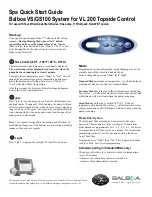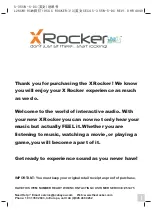
English
GREAT BRITAIN • customer service tel: 0845 300 9799 e-mail: [email protected] internet: www.clasohlson.com/uk
1
2
4
3
5
6
7
8
Ver
. 20140722
Z-Wave Multisensor
Art.no 36-5746
Model DSB05-ZWEU
Please read the entire instruction manual before using the product
and then save it for future reference. We reserve the right for any
errors in text or images and any necessary changes made to
technical data. In the event of technical problems or other queries,
please contact our Customer Services.
Things to consider:
• Other wireless equipment using the same frequency band can
reduce the transmission range.
• The range of all wireless equipment depends on the type of
obstacles located between the transmitter and the receiver
(e.g. a concrete wall will interfere with the signal more than
a plasterboard wall).
If you experience problems, try the following:
• Turn off any other existing wireless equipment to check whether
this is the cause of the problem.
• Reposition the wireless equipment, shorten the distance
between the transmitter and the receiver or reduce the number
of obstacles (walls, furniture, etc.) between them.
Safety
• Never subject the sensor to high temperature, dust, heavy
vibration, impacts, humidity or moisture.
• Never attempt to dismantle or modify the sensor as it contains
no user-serviceable parts.
Product description
Z-Wave DSB05-ZWEU 4-in-1 Multisensor
Battery powered, wireless sensor for use with Zipabox Duo and
other Z-wave-system products, regardless of make. Motion sensor,
temperature sensor, humidity sensor and light sensor.
PIR sensor/motion sensor
The PIR sensor can be used to actuate the majority of the devices
in your Z-wave system, such as activate a burglar alarm, turn a light
on or execute other commands.
Temperature and humidity sensor
By monitoring the temperature and humidity of a space it is possible
to programme the Z-Wave system to remotely control devices to
create the perfect atmosphere.
Light sensor
By programming in commands or scenarios, the light sensor can be
used to control devices depending on the level of light at the place
where the sensor is placed.
The sensor comes with mounting plates for attaching it to the wall
or ceiling. It can be used indoors or outdoors and can send signals
to up to six other Z-Wave devices.
For more information please visit
www.aeotec.com
for a complete
instruction manual.
1. Motion sensor
2. LED indicator
3. [ Sensitivity ] Sensitivity dial
4. Temperature and Humidity sensor
5. Z-Wave Button – Button for pairing to Z-Wave system
6. USB port
7. Mounting arm (ball-joint mount for wall or ceiling)
8. Mounting plate (fixed mount for wall or ceiling)
USB or battery power
• Batteries should be used for periodic use.
• The USB port should be used for continuous use.
Batteries
4. If your Z-Wave system can display the battery level of
the multisensor, the battery status will be displayed once
the multisensor has been paired to the system.
5. If your system does not have a method of displaying the battery
level, it is recommended that the batteries are checked regularly.
USB port
Mounting
Fixed mounting plate
1. Twist the battery cover to
the unlocked position and
remove it.
2. Insert 4 × AAA/LR03 batteries.
Note the polarity markings in
the battery holder to ensure
correct battery insertion.
3. Refit the battery cover and twist it
to the locked position.
1. Twist the battery cover to
the unlocked position and
remove it.
2. Connect the included USB
lead to the charging port (6)
on the multisensor and to
a computer or other USB
charger.
3. Refit the battery cover
and twist it to the locked
position.
Motion sensor effective range
When mounted on the ceiling
Ceiling
Floor/Ground
Floor/Ground
When mounted on a wall
Installation/Pairing
1. Set your Z-Wave control device to learning mode.
2. Push the Z-Wave button (5) on the sensor to connect it to your
existing Z-Wave network.
3. The Z-Wave button can also be used to test whether
the connection/pairing process was successful. If the LED
indicator (2) flashes when the Z-Wave button is pressed,
the sensor is not paired. If the LED indicator shines steadily for
a few seconds when the Z-Wave button is pressed, the sensor
is paired.
1. Mount the fixed mounting plate
(8) to the ceiling or wall using
suitable screws and wall plugs.
Make sure that there are no
hidden electrical cables or water
pipes in the wall/ceiling which
could be damaged by drilling
the mounting holes.
2. Hook the sensor onto
the mounting plate.
Mounting arm
1. Mount the mounting arm (7) to the ceiling or wall using suitable
screws and wall plugs. Make sure that there are no hidden
electrical cables or water pipes in the wall/ceiling which could be
damaged by drilling the mounting holes.
2. Remove the screw
from the centre (ball) of
the mounting arm.
4. Hook the sensor onto
the mounting plate.
5. The mounting arm can be
locked in various angles
by turning the Friction
Lock clockwise, adjusting
the angle, and then
turning the Friction Lock
anticlockwise.
3. Screw the fixed mounting
plate to the mounting arm.
Care and maintenance
• Clean the product using a lightly moistened cloth. Use only mild
cleaning agents, never solvents or corrosive chemicals.
• Remove the batteries and disconnect the USB cable from
the sensor if the product is not to be used for an extended
period.
Disposal
This product should be disposed of in accordance with local
regulations. If you are unsure how to proceed, contact your
local council.
























